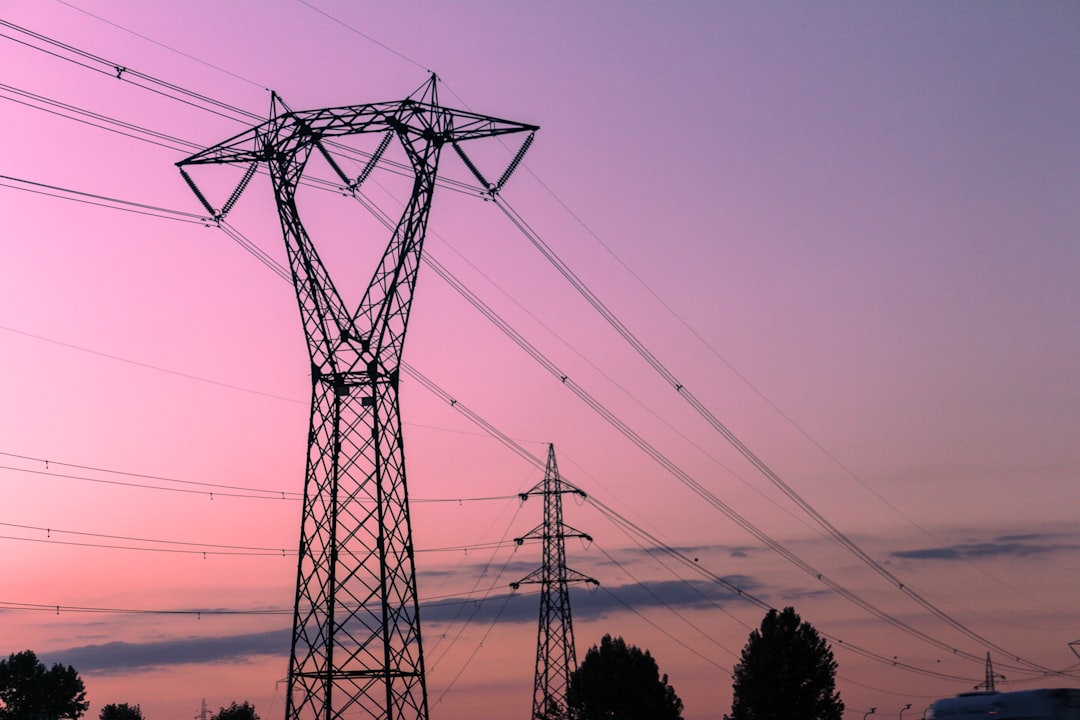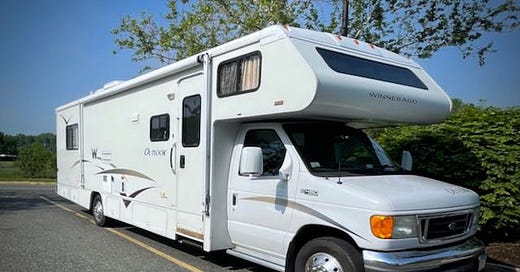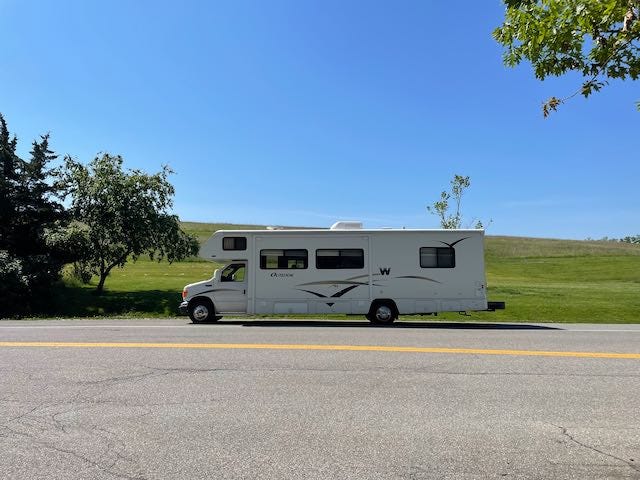Welcome to the Quarantine Creatives newsletter, a companion to my podcast of the same name, which explores creativity, art, and big ideas as we continue to live through this pandemic.
If you like what you’re reading, you can subscribe for free to have this newsletter delivered to your inbox on Sundays:
There was no new episode of the podcast this past week as I took some time off for Memorial Day. New episodes will resume on June 16.
Today, I have a travel log of a recent trip, which caused me to reflect on my attitude towards energy and pollution. After reading, please feel free to leave a comment as I’d love to hear your thoughts about this topic too!
How I Spent My Vacation… (thinking about electricity)
Now that summer is almost here, my family and I have been spending time camping in our RV. We bought it towards the end of last summer and love the convenience of having the comforts of “home” with us, whether that’s a frying pan or a toothbrush.
But I also have a mixed relationship with the RV lifestyle, in particular driving a 32 foot long house that gets at best nine miles to the gallon. I love making memories with my kids, but I hate the idea that I am polluting their future. Because of this, I try to find ways to be as energy conscious as I can when we travel in the motorhome.
Case in point, on a recent trip, the high temperatures here in the Northeast exceeded 90º Fahrenheit (that’s over 32ºC for you Metric folks). It was hot! Even so, I was reluctant to turn on the gas generator in the RV, which provides power to the air conditioner and other high draw appliances when we’re away from a power outlet.
The generator is attached to the frame of our motorhome, but is otherwise just like a portable generator. It takes regular unleaded gasoline out of the same fuel tank as the engine, it sounds a bit like a lawn mower when it’s running, and there’s an exhaust pipe where combustion products fill the air outside with a distinct smell.
We had originally planned to “boondock” for the entire weekend, which means that we would sleep in the RV without being connected to any power source. There’s a lithium battery on board that powers our lighting and a few other circuits, but it doesn’t run the air conditioner, although it was comfortable that first night, so we didn’t need it. We spent our first night in a Cracker Barrel parking lot in New Jersey, and it was surprisingly lovely (you can read about it on my Instagram).
When the temperature got unseasonably warm on our second day, we fired up the generator for a while to keep us cool. It may seem like air conditioning when camping is a luxury, but an RV is a vehicle just like a car. The windows are thin and the walls have limited insulation- it’s just not the same as being in a house without AC. It can easily be 10º warmer inside the coach than the outdoor temperature when the sun is out.
Listening to that generator run, smelling those gas fumes, and thinking about the higher price of gas right now made us reconsider if we could continue to boondock that night. We began to Google nearby campgrounds where we could plug in our RV and run the air conditioner all night if we needed without firing up the generator.
I thought I was making a smart decision at the time. Why burn all that gasoline to run a generator when I had the much “cleaner” and quieter option of being plugged in to a campground outlet? After all, the power at a campground is much like the power we use at home. It’s just kind of there, right?
As I sat in my cooled down motorhome, tethered to a power outlet, it occurred to me that the campground’s electricity might not be any cleaner than our on-board generator, or at least that trying to calculate which was cleaner was complicated.
60% of our electricity in the U.S. comes from burning a fossil fuel like natural gas or coal. It’s still a loud, smelly process to make power, it’s just not as immediate as hearing a generator running and smelling the fumes steps from your bed.
Being plugged in at a campground meant that I wasn’t suffering from the direct effects of making my power, but other people certainly were. When it comes to electricity generation, according to the EPA:
“Minority, low-income, and indigenous populations frequently bear a disproportionate burden of environmental harms and adverse health outcomes, including the development of heart or lung diseases, such as asthma and bronchitis, increased susceptibility to respiratory and cardiac symptoms, greater numbers of emergency room visits and hospital admissions, and premature deaths.”
There are great inequities like this built into the structure of our country, from power generation to the location of interstates to the accessibility of parks. If you’re interested in learning more, I highly suggest Heather McGhee’s book The Sum of Us. Many of these structures have been in place for decades (some for centuries), and we are only starting to reckon with the true costs.
There are the hidden costs of our energy system, but there are also the very tangible costs, which are felt every time we buy gas at the pump or pay our electric bill. As concrete as these costs may seem, our attitude towards them can be wildly fluid, with little basis in reality.
My generator uses about a gallon of gas every two hours. At $5 per gallon, that’s $15 worth of fuel to run the generator for 6 hours before bed. We paid close to $100 for a campground where we hardly made use of the other amenities besides the “free” electricity, but it seemed to make economic sense because “gas prices are high.”
Most of us probably do similar mental gymnastics when it comes to how we approach energy. We may be obsessive about turning off lights when we leave a room to save power but will happily run our air conditioning cold. With the ubiquity of LED lighting, the savings from turning off lights is almost imperceptible, whereas adjusting the thermostat could make a meaningful impact on your bill.
The good news is that about 20% of the electricity generated in this country is now coming from renewable sources like solar, wind, or hydropower, and it has been on the rise for many years. This power doesn’t pollute in the same way that burning fossil fuels does, and it can also be produced anywhere.
You would notice smokestacks billowing coal ash over your neighborhood from a power plant, but you may not even realize that renewable energy is being produced nearby. Large retailers like Target and Wal-Mart have been quietly installing solar panels on their store roofs for years. I only happened to find out that my local Target store had a massive solar array by stumbling on a satellite view. (Check the satellite view for your local Target or Wal-Mart and let me know in the comments if it has panels- many do!)
The idea that every rooftop can be a power plant is known as distributed energy. Instead of one or two central power plants lighting up a region, with distributed energy, hundreds or thousands of discreet sources are all adding electricity to the grid.
Distributed energy is often conflated with renewables, but fossil fuels can be distributed as well. In my This Old House days, I produced a segment in Germany looking at European renewable technology. What stuck with me from that trip was an appliance known as a CHP, which stands for Combined Heat and Power unit.
The CHP we saw was a wall-mounted natural gas generator. Its primary purpose was to burn natural gas to create electricity, similar to the generator on my RV (though mine uses gasoline). Generators (like any combustion engine) get hot, and these CHPs can capture that warmth in a heat exchanger and use it to heat water, which could then be used for washing, showering, or even heating radiators to keep the house warm. It was making power and heating with a single appliance.
When the CHP produced more power than could be used by the home, it sold that excess power to the grid to be used by neighbors (much like many solar systems operate).

The thought of running a generator like a CHP all day seemed crazy to me at the time, but one of the advantages was that it was incredibly efficient. Transporting electricity over power lines results in power loss, whereas generating it on site results in much less power loss.
If generating on site is more efficient than transporting power from a plant, should I be running my RV generator more and staying at campgrounds less? Probably not, because small gas engines like generators, lawn mowers, chainsaws, and leaf blowers are still heavy polluters. Unlike car engines, they lack pollution controls like catalytic converters. In fact, California has banned the sale of small gas engines starting in 2024, which includes RV-mounted units like mine, citing air pollution concerns.
Likewise, the CHP that I saw in Germany conforms to modern efficiency standards that exist for other combustion appliances like water heaters, boilers, and furnaces. It’s a similar concept to my RV generator, but it burns much cleaner.
All of this begs the question of why not use a technology like solar panels on an RV instead of the gas generator?
I considered that earlier this year. When I bought our RV, the generator wasn’t working. I took it to a repair shop and had them troubleshoot it, but there were several problems with it and it made more sense to simply replace the generator with a new one. This came at a considerable cost though.
I contemplated not replacing the generator at all and instead putting that money towards a solar array on the roof of the RV, a larger battery bank (to store the sunlight during the day for use at night), and an inverter that would allow the energy in the 12 volt batteries to be used by 120 volt appliances, like the air conditioning and microwave.
We’ve had solar panels on our house for more than a decade and they have been amazing! However, our home is still tied into the grid, so on a hot summer day when we have the AC running, are cooking on our electric stove, and are watching TV, our solar panels don’t need to power everything; the grid can pick up the slack.
In the RV, our solar array would need to be sized appropriately to make and store enough power for our needs, with no guarantee for where we’d be parked at any given moment (solar panels don’t work as well at a wooded campsite). Plus, the real estate available on my RV roof for panels is limited.
In the end, solar technology for an RV isn’t quite there yet, at least at a price point that made sense for me. Running an air conditioner is the most challenging part, and it requires a large inverter and a large battery bank. I could’ve easily spent $8,000-10,000 simply on the components for a system, and that wouldn’t have included installation.
There are more affordable solar options, but they can only be used to recharge the on-board batteries and cannot run larger appliances.
I ultimately decided to stick with the gas generator for now, with the promise that I would use it as little as possible.
Just like an RV is basically a small house on wheels, an RV’s energy system is a small version of what happens in the real world, which is why I was inspired to explore this topic.
Solar and other renewables make sense in some cases, but as long as fossil fuels are a part of the package, we need to consider how we can use them responsibly and be aware of who is shouldering the largest burden.
Related Reading
If you’d like to catch up on past episodes of the Quarantine Creatives podcast, they can be found on Apple Podcasts, Spotify, or wherever you listen.
Please consider sharing this with a friend that you think might enjoy it, or better yet, share it on social media so you can tell hundreds of friends!
If you’ve missed past issues of this newsletter, they are available to read here.
Stay Safe!
Heath










